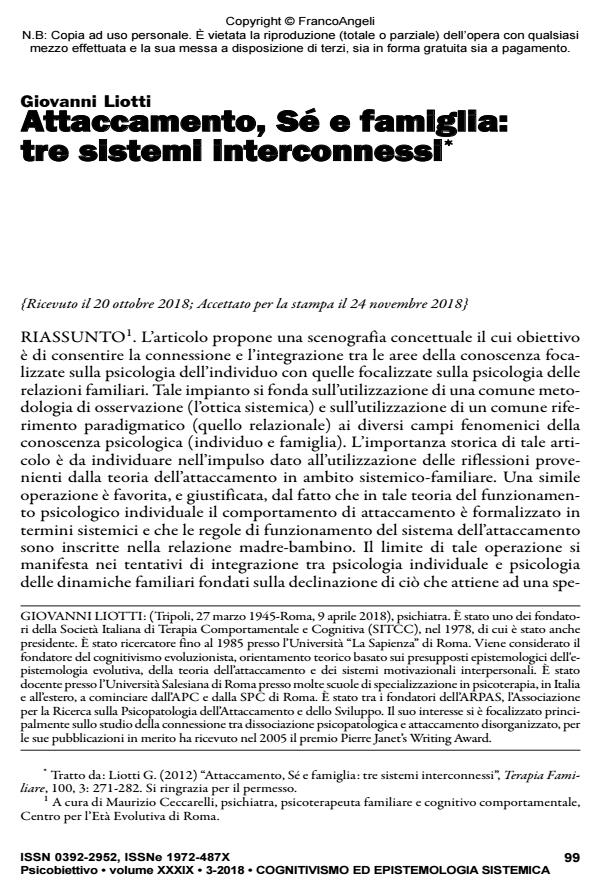Attaccamento, Sé e famiglia: tre sistemi interconnessi
Titolo Rivista PSICOBIETTIVO
Autori/Curatori Giovanni Liotti
Anno di pubblicazione 2018 Fascicolo 2018/3
Lingua Italiano Numero pagine 12 P. 99-110 Dimensione file 119 KB
DOI 10.3280/PSOB2018-003010
Il DOI è il codice a barre della proprietà intellettuale: per saperne di più
clicca qui
Qui sotto puoi vedere in anteprima la prima pagina di questo articolo.
Se questo articolo ti interessa, lo puoi acquistare (e scaricare in formato pdf) seguendo le facili indicazioni per acquistare il download credit. Acquista Download Credits per scaricare questo Articolo in formato PDF

FrancoAngeli è membro della Publishers International Linking Association, Inc (PILA)associazione indipendente e non profit per facilitare (attraverso i servizi tecnologici implementati da CrossRef.org) l’accesso degli studiosi ai contenuti digitali nelle pubblicazioni professionali e scientifiche
L’articolo propone una scenografia concettuale il cui obiettivo è di consentire la connessione e l’integrazione tra le aree della conoscenza focalizzate sulla psicologia dell’individuo con quelle focalizzate sulla psicologia delle relazioni familiari. Tale impianto si fonda sull’utilizzazione di una comune metodologia di osservazione (l’ottica sistemica) e sull’utilizzazione di un comune riferimento paradigmatico (quello relazionale) ai diversi campi fenomenici della conoscenza psicologica (individuo e famiglia). L’importanza storica di tale articolo è da individuare nell’impulso dato all’utilizzazione delle riflessioni provenienti dalla teoria dell’attaccamento in ambito sistemico-familiare. Una simile operazione è favorita, e giustificata, dal fatto che in tale teoria del funzionamento psicologico individuale il comportamento di attaccamento è formalizzato in termini sistemici e che le regole di funzionamento del sistema dell’attaccamento sono inscritte nella relazione madre-bambino. Il limite di tale operazione si manifesta nei tentativi di integrazione tra psicologia individuale e psicologia delle dinamiche familiari fondati sulla declinazione di ciò che attiene ad una specifica condizione motivazionale (la vulnerabilità personale che sostiene l’attivazione dell’attaccamento) e che si esprime in uno specifico contesto interattivo (la relazione diadica fondata sulla dinamica attaccamento/accadimento) ad una trama relazionale squisitamente gruppale (la famiglia). Il successivo sviluppo del pensiero dell’Autore, orientato a definire una molteplicità di sistemi motivazionali (attaccamento, accudimento, agonismo, cooperazione, affiliazione), molteplicità motivazionale correlata ad una molteplicità di contesti interattivi in cui essi si sviluppano e in cui si esercitano (diadici, triadici, gruppali, socioculturali), offre una griglia teorica che risponde in modo maggiormente adeguato alla complessità dell’operazione tesa all’integrazione tra i dati della conoscenza relativi all’individuo con quelli relativi alle trame relazionali. In questo complesso quadro teorico, la centralità del riferimento al concetto di sistema motivazionale, inteso come tendenza innata del soggetto a relazionarsi con il mondo (fisico, interpersonale, socioculturale) consente all’Autore di accogliere i dati di conoscenza propri dell’ambito della biologia evoluzionista ed evolutiva, delineando in tal modo una teoria sull’essere umano di natura squisitamente biopsicosociale. Affermare l’indissolubile combinazione, tanto nella costruzione quanto nel mantenimento della mente, tra la natura irriducibilmente biopsicosociale di essa e l’intrinseca dimensione relazionale di quella natura, permette all’Autore di considerare i diversi contesti di intervento terapeutici (individuali, gruppali, familiari, comunitari) come strumenti di cura la cui diversità attiene semplicemente all’attivazione e all’esercizio dei diversi contesti relazionali di cui si nutre, e in cui si esprime, la mente. In quest’ottica l’organizzazione di senso terapeutico di quegli strumenti, compresa la loro eventuale combinazione (terapie integrate), può essere compiutamente definita solo grazie ad un processo negoziale tra terapeuta e paziente, all’interno della specifica e sempre singolare relazione tra essi.
Parole chiave:Attaccamento; sé; famiglia; sistema motivazionale; coscienza
Giovanni Liotti, Attaccamento, Sé e famiglia: tre sistemi interconnessi in "PSICOBIETTIVO" 3/2018, pp 99-110, DOI: 10.3280/PSOB2018-003010